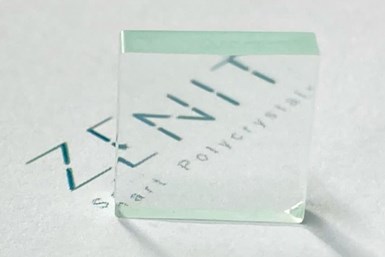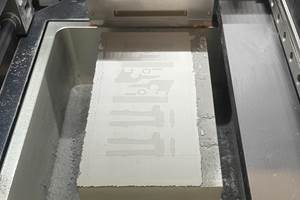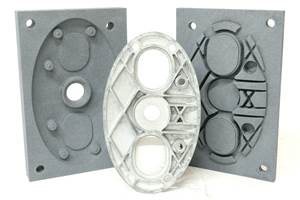Lithoz Supports Zenit Smart Polycrystals’ Materials for Solid-State Lasers
The collaboration includes alignment of Lithoz’s lithography-based Ceramic Manufacturing (LCM) technology for the Zenit process, as well as support for market, organization and innovation strategies.
Lithoz, a provider for ceramic 3D printing, has signed a partnership agreement to support the Italian startup Zenit Smart Polycrystals with entering the solidstate lasers (SSL) market using its process of 3D printing transparent polycrystal components. Zenit is a spin-off from CNR-ISTEC and is based in Faenzak, Italy.
The partnership agreement between Lithoz and Zenit will support the further development and go-to-market of Zenit’s process of 3D printing transparent polycrystal components with variable threedimensional chemical compositions. In addition to the alignment of Lithoz’s lithography-based ceramic manufacturing (LCM) technology for the Zenit production process, the collaboration includes market, organization and innovation strategies.
Lithoz will support the Zenit team on a technical level in aligning its process to the LCM 3D printing technology which the company says is considered the industrial standard for ceramic 3D printing. It will also consider Lithoz's own expertise as both a spin-off and startup in a this innovative, dynamic market environment. Consequently, Lithoz will support its Italian partners along the way to entering the market in terms of answering questions related to innovation strategy, market analysis, licensing and organization.
Lithoz was created as a spinoff 11 years ago from the TU Wien by Dr. Johannes Benedikt and Dr. Johannes Homa. Since then, the company has grown, offering a range of ceramic 3D printers used for various industrial and medical applications.
Zenit, founded last year, will use Lithoz’s LCM process to take its invention to the next level. It is said the printed components feature varying three-dimensional compositions, creating an improved polycrystal material which outperforms the current dominant laser-based technology. By using the ultraprecise LCM technology — which enables equal or superior material properties as those of components produced using conventional forming methods — these smart components can be made even more efficiently to improve performance and open the door to a new generation of new projects.
Lithoz says it actively supports customers in their efforts to bring new applications to the product level through a proactive mutual exchange of experiences and know-how with customers. Working together with clients, the company makes it possible to overcome obstacles and find new methods to achieve its goals by providing maximum support in development by Lithoz experts and engineers.
“Having been working in research and industry for more than 10 years, it is fantastic to see how our industry is growing and being seen as one of the top markets to watch,” says Johannes Homa, Lithoz CEO. “Partnerships are one of our most important values at Lithoz and we invite any innovator looking for support in a challenging project to collaborate with us. We work together with our partners to overcome even the most difficult of technological challenges and to make the future of ceramics happen already today.”
- Watch this episode of The Cool Parts Show to learn about Lithoz’s 3D printed bioceramics that can take the place of both cortical and cancellous bone.
- Learn how Lithoz offers improved ceramic material for 3D printed bone replacements which are patient-specific parts made of hydroxyapatite for bone replacements in the medical and dental field.
- At Formnext 2022, Lithoz showcased its CeraFab S65 ceramic 3D printers which have database-supported storage and management of all process data, enabling seamless documentation of print jobs.
Related Content
3D Printed Reactor Core Makes Solar Fuel Production More Efficient
The solar reactor uses water and CO2 from the air and sunlight as the energy source to produce carbon-neutral liquid fuels, for example, solar kerosene for aviation.
Read More8 Cool Parts From Formnext 2023: The Cool Parts Show #65
New additive manufacturing technologies on display at Formnext were in many cases producing notable end-use components. Here are some of the coolest parts we found at this year’s show.
Read MoreAM 101: What Is Binder Jetting? (Includes Video)
Binder jetting requires no support structures, is accurate and repeatable, and is said to eliminate dimensional distortion problems common in some high-heat 3D technologies. Here is a look at how binder jetting works and its benefits for additive manufacturing.
Read MoreFoundry Lab: How Casting in a Day Will Improve the Design of Metal Parts (Includes Video)
The company’s digital casting process uses 3D printing, but the result is a cast part. By providing a casting faster than a foundry, the company says effective prototyping is now possible for cast parts, as well as bridge production.
Read MoreRead Next
Postprocessing Steps and Costs for Metal 3D Printing
When your metal part is done 3D printing, you just pull it out of the machine and start using it, right? Not exactly.
Read MoreAlquist 3D Looks Toward a Carbon-Sequestering Future with 3D Printed Infrastructure
The Colorado startup aims to reduce the carbon footprint of new buildings, homes and city infrastructure with robotic 3D printing and a specialized geopolymer material.
Read MoreProfilometry-Based Indentation Plastometry (PIP) as an Alternative to Standard Tensile Testing
UK-based Plastometrex offers a benchtop testing device utilizing PIP to quickly and easily analyze the yield strength, tensile strength and uniform elongation of samples and even printed parts. The solution is particularly useful for additive manufacturing.
Read More





















